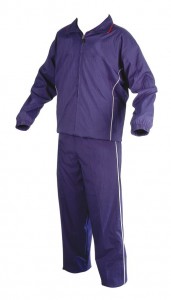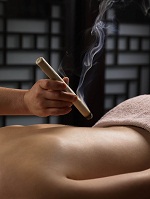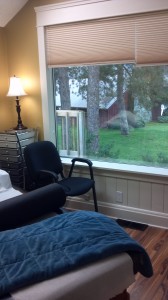Acupuncture is a safe and effective healing art backed by more than two thousand years of practice and research. It is used worldwide both as a primary and adjunctive treatment for a wide range of conditions. Generally, people find an acupuncture treatment to be a relaxing experience. This is especially so after they get over any initial hesitation regarding needling. The information below is intended to provide you with basic information regarding what you might experience with your first acupuncture visit.
Your First Visit
Comfortable, loose clothing is the best option for your acupuncture treatments. In general, most points can be easily reached with some simple adjustments to loose clothing such as: rolling up pant legs to the knees, or pushing longer sleeves up.

Your first visit is longer than your followup visits as it may entail quite a bit more questioning. The intial questioning is a very important part of the care I can provide to you. While many of the questions may seem entirely irrelevant to your condition, for example, asking the quality of your bowel movements when you came in for back pain, or your psychological state when you came in for menstrual problems, there are very good reasons behind the questions. The answers you provide to the questions, along with other basic diagnostic tools such as: looking at your tongue and feeling your pulse, allow acupuncturists’ to individualize the treatment specifically to you.
The individualization of the treatments is one of the strong points of Chinese Medicine. It is why people may experience broad changes within themselves after receiving acupuncture for a specific complaint. It also means that the treatments may be modified over time as the condition changes.
Your Diagnosis and Treatment
After the initial questioning and checking your pulse and tongue, a diagnosis and treatment plan will be created and the acupuncture treatment will begin. In most cases, the initial treatment is fairly conservative to ensure that you are comfortable and to allow an opportunity to see how you respond to acupuncture.
Based on your diagnosis, the initial treatment may use 3 – 10 or more acupuncture points. For example, an initial treatment for headache may use these three points: LI 4, GB 20 and TH 5.
Generally speaking, your diagnosis in Chinese Medical terms can be confusing and misleading. For example, a diagnosis of Kidney Qi and Yin Deficiency may not mean very much to you. The diagnosis may make you think there is something wrong with your physical Kidneys when it is likely that there is not. Nonetheless, the terms used are important to practitioners.
However, I like to describe the treatment and the intent with the points. I also enjoy taking the time to explain what the terminology means and how it impacts your body. After all, the more you know about yourself, the more you will be able to address your health. After the treatment, I offer a prognosis along with a basic treatment plan. I may also offer various beneficial lifestyle changes which may help to improve your overall condition. This may include dietary changes, exercise, meditation, etc.
Needles and Adjunctive Techniques
•What are the needles like?
The needles used within acupuncture are both sterile and extremely thin. Most people are surprised to see how thin the needles actually are. They range in width from approximately .14 mm to .30 mm and in length from 15 mm (.5 inch) to 75 mm (3 inches). The most commonly used needle is a 25 mm (1 inch) .25 mm width needle. Generally, they are inserted about 1-3 mm into the body – deeper on fleshy areas such as the buttocks.
•What will I feel?
The sensation you will feel when being needled is generally fairly minimal. In some styles you will feel almost nothing, while in others the needle will be rotated slightly until you feel a heavy or distended feeling indicating the arrival of qi.
•How long will the treatment last?
After the needles are inserted you are usually left to rest for a period of 10 – 45 minutes. Within some styles the needles are inserted quickly and removed immediately and in others they are left in for a longer period of time. Most people feel fairly relaxed during this period and many simply fall asleep.
In many cases your treatment may consist of points on the front and back of your body. I may insert needles on the front, let you rest for awhile and then remove them, have you turn over and continue the treatment on your back.
•What other techniques may be part of my treatment?
Acupuncture is simply one facet of oriental medicine. Within an acupuncture treatment an acupuncturist may choose to utilize various adjunctive techniques depending on your condition and their training. These may include the following:
•Electro-acupuncture – the acupuncture needles are stimulated with an electric charge delivered from a machine. This is used often and effectively in patients dealing with pain.

•Moxibustion – this involves the burning of an herb – Artemesia Vulgaris – either on the top of a needle or on the skin directly. This is used often in patients who are dealing with cold or stagnant conditions such as certain types of abdominal cramps.
•Cupping – this involves the use of glass or plastic cups which are placed on the body with suction to help remove toxins and muscle tension. They are used often in patients with immune issues such as a cold as well as for pain.
Prognosis and Treatment Plans
A definitive prognosis is always difficult to formulate, especially following an initial consultation. After the first 2-3 treatments, however, I should have a good understanding of your condition and be able to offer you a reasonable idea of how many treatments you will need.
While many people will feel some change in their condition immediately or within the first 2-3 treatments, others with more serious or recalcitrant conditions will need many months of treatment before a significant change occurs. If you are not noticing any changes it does not mean that acupuncture is not helping you. Many times the changes are slow and somewhat subtle as the entire body begins to rebalance from the condition. During these intial stages, I can usually guage the relative effectiveness of the treatments through precise questioning and by monitoring subtle changes in your tongue a/or pulse.

In the most general terms possible, 1 month of treatment may be necessary for each year that a condition has been active. For example, if you have had dysmenorrhea for the past 5 years you may need approximately 5 months of treatment before you will see a resolution. If you are experiencing acute backpain, you may receive immediate relief of the acute pain but may need further treatments to account for the underlying factors which led to the acute flareup.

